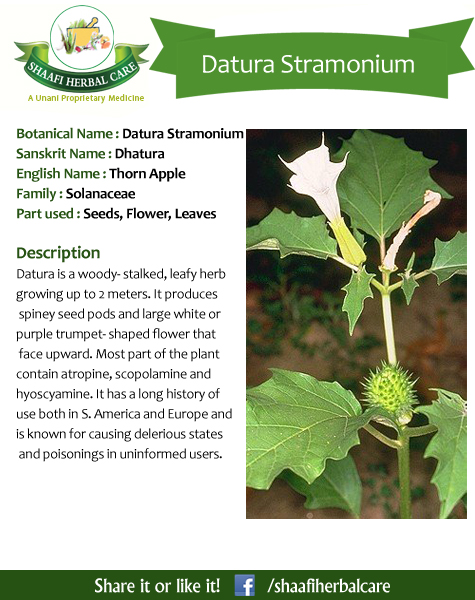
Description
Datura is 30 to 150 cm tall, with erect, forking and purple stems. The leaves are large, 7 to 20 cm long and have irregular teeth a la oaks. The flowers are one of the most distinctive characteristics of datura. They open and close, at irregular intervals, during the evening. The native range of the plant continues to remain ambiguous. It is believed that the birds carry the seeds of the datura and spread it in their droppings. The seed lies underground for a long time and germinates whenever the soil is disturbed.Plant Chemicals
Datura leaves contain the same alkaloids as Belladonn, though in smaller proportions. The mid-rib and footstalk of the leaf contain a far larger proportion of alkaloids than the blade. The alkaloid consists chiefly of hyoscyamine, associated with atropine and hyoscine (scopolamine). Malic acid is also present.
Datura is 30 to 150 cm tall, with erect, forking and purple stems. The leaves are large, 7 to 20 cm long and have irregular teeth a la oaks. The flowers are one of the most distinctive characteristics of datura. They open and close, at irregular intervals, during the evening. The native range of the plant continues to remain ambiguous. It is believed that the birds carry the seeds of the datura and spread it in their droppings. The seed lies underground for a long time and germinates whenever the soil is disturbed.Plant Chemicals
Datura leaves contain the same alkaloids as Belladonn, though in smaller proportions. The mid-rib and footstalk of the leaf contain a far larger proportion of alkaloids than the blade. The alkaloid consists chiefly of hyoscyamine, associated with atropine and hyoscine (scopolamine). Malic acid is also present.
Uses & Benefits of Datura
- datura is internally used in relieving the spasm of bronchitis in asthma. It is also used in the treatment of Parkinsonism and Hemorrhoids. Its leaves, applied after roasting, are useful in relieving pain.
- The bitter narcotic plant relieves pain and encourages the healing process. The plant has a very long history of being used as herbal medicine.
- Its leaves, flowering tops and seeds have anodyne, antiasthmatic, antispasmodic, hallucinogenic, hypnotic, mydriatic and narcotic properties. The seeds of the plant are the most active medicinally.
- datura is internally used for treating giddiness, dry mouth, hallucinations and coma.
- Externally, the plant is used as a poultice in treating fistulas, abscesses wounds and severe neuralgia.
- Traces of scopolamine are also found in the plant, which is a potent cholinergic-blocking hallucinogen that has been used to calm schizoid patients.
- Its leaves, containing hyoscyamine and atropine, can be used as an immensely powerful mind-altering drug.
- The seeds of datura are analgesic, anthelmintic and anti-inflammatory and as such, they are used in the treatment of stomach and intestinal pain that results from worm infestation, toothache, and fever from inflammations.
- The juice of its fruit is applied to the scalp, to treat dandruff and falling hair.
- The growing plant works as an insect repellant, which protects neighboring plants from insects.


